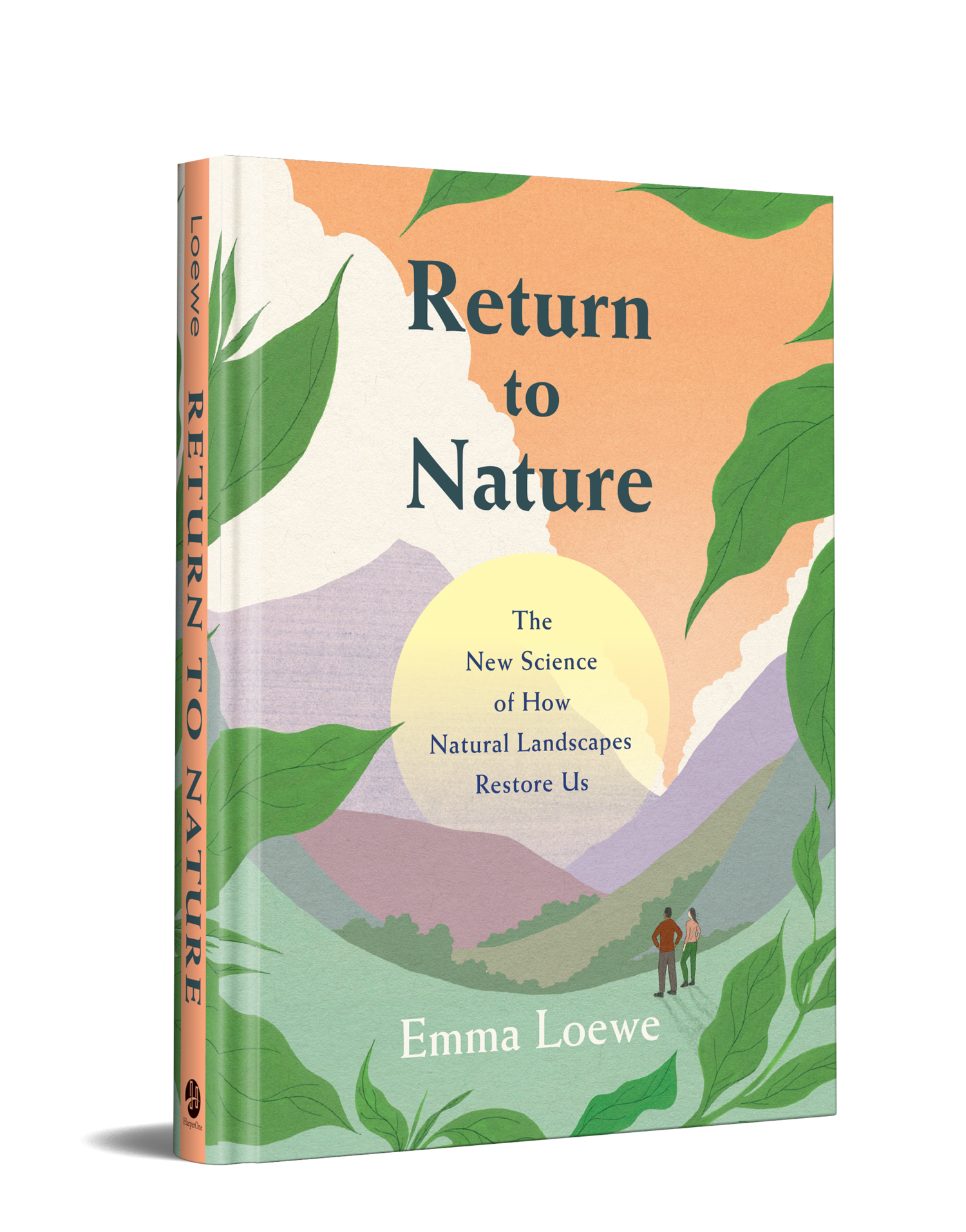Nature’s Medicine: Grounding Activities to Get Spiritually Grounded, from the Return to Nature Book
The following article with grounding activities you can try in your daily life to get spiritually grounded is a special excerpt offering, written by our friend Emma Loewe, from her wonderful Return to Nature book.
The Spiritual Potential That Lives Where Humans and Nature Meet
Science plays an integral role in explaining the impact of nature experience on humans – but it can only go so far.
The scientific process studies all that can be measured. And though it casts a wide net, it will always fall a little short when attempting to define something as vast as “the health benefits of nature.”
Where it leaves off, a type of spirituality picks up. I think of spirituality as a connection that has some degree of randomness to it.
In the outdoors, it might look like a moment of ecstasy, a feeling of total peace, or an unexplainable serenity and clarity in the presence of a new view.
For me, it can come when I’m walking on the beach near where I grew up, running along the Hudson River in Manhattan, or standing under a really big tree.
While Western philosophies of expansion, growth, and profit have physically separated us from nature, our innate spiritual connection to it remains.
In their work, the Kaplans found that wholeness, oneness, and purity were words that people often used to describe their wilderness experience. It’s easy to draw parallels between this nature vernacular and that of a church, temple, or place of worship for some higher power.
With this in mind, I wanted to carry this book beyond the quantifiable and into the realm of the unproved and unprovable: to, as the ecological scientist and member of Citizen Potawatomi Nation Robin Wall Kimmerer writes in Braiding Sweetgrass: Indigenous Wisdom, Scientific Knowledge, and the Teachings of Plants, “be bilingual between the lexicon of science and the grammar of animacy.”
So, alongside measures of heart-rate variability and brain waves, you’ll find descriptions of archetypes, fables, and spiritual and religious philosophies that further probe how nature makes us feel in body and mind.
I present these side by side not to conflate faith and science or discount the significance of rigorous research (or religion, for that matter). I do it because I believe that together, the two can form a more complete picture of what happens when we step outside.
This blog is an excerpt from Return to Nature, a beautiful book by Emma Loewe we think you’ll love to learn more about getting spiritually grounded with a variety of grounding activities you can try regardless of your location and schedule. You can buy it here. TheAncientWay.co may earn a commission for any sale through our website. We appreciate your support in furthering our mission of serving as a bridge between ancient wisdom and modern living.
Grounding Activities to Get Spiritually Grounded in Your Daily Life, from Return to Nature
Parks and Gardens Practices
If you have 5-10 minutes:
Take a tech-free microbreak.
If the sight of grass and the sound of birds immediately put us at ease, our tech does the opposite.
Even though scrolling through social media or reading n article online seems like a relaxing enough way to spend a few minutes, the psychologists I’ve talked to agree that it drains cognitive resources.
“People use those activities as a break – as a way to relax or destress. And what’s actually happening is that those activities are putting them at an even greater attentional deficit,” Jason Duvall, a lecturer at the University of Michigan Program in the Environment, tells me.
“If you have people take cognitive functioning tests before and after those activities, it’s very likely they would perform worse afterwards.”
On the other hand, looking at greenery for as little as forty seconds at a time seems to improve mental capacity, based on findings from Australia.
In that research, 150 university students took cognition tests after looking over a computer image of a bare patch of roof or a green roof covered in a garden for forty-second spurts.
On average, the students who looked at the green roof image made fewer errors after their microbreaks than those who looked at the bare roof: proof that sometimes letting yourself rest (with nature in sight) is the most productive thing you can do.
So instead of mindlessly scrolling (which might not be so mindless after all), take your next short break from work, chores, childcare, and so forth in a park or patch of grass if you have one near home.
If you can’t get outside, look out the window for a minute or so and just let the mind settle on any green you can see. Whatever you do, leave the phone behind.
Grounding Activities to Connect with Mountains and Highlands
If you have 5-10 minutes:
Expand the breath to eleven counts in the presence of mountains.
Melanie Rudd, an awe researcher and associate professor at the University of Houston, has found that slow and controlled breathing can ground us in the present moment (and subsequently expand our sense of time) in a similar way that awe tends to.
Apply this research by following a slow, mindful breath pattern of a five-second inhale and a six-second exhale as you gaze at a mountain view in order to open yourself up to, as Rudd puts it, be awed by something you might not have noticed or fully appreciated otherwise.
Connecting from afar:
Look at photos or videos.
It turns out that there’s something to those preset desktop backgrounds that show the granite walls of El Capitan and sunsets over the Sierras: photos and videos can elicit a bit of awe in us too – the more immersive, the better. To tap into the feeling of the mountains from afar, Rudd recommends keeping a folder of awe-inspiring nature images on rotation on your phone or computer. There’s a point at which the same photo will stop delivering an awe response, so swap them out every so often to keep things fresh.
Get Spiritually Grounded with Forests and Trees Practices
If you have 5-10 minutes:
Take your lunch break under the canopy.
When he’s not leading forest baths for research, Qing Li finds a similar peace by spending his midday work breaks in a small city park near his office. While eating lunch, he sits under a tree and engages with his surroundings using all the senses.
He isn’t the only one who finds the canopy a comforting eating companion: when I wrote to the legendary Jane Goodall for an interview during COVID-19’s lockdown, she told me that she, too, had been spending a sensory lunch break outside, in the yard of the home where she was quarantined. She sat under a favorite beech tree, listened to the daily robin song, and softly sang back between bites.
Get to know one tree.
Chances are, you pass hundreds of trees every day without paying much attention to what they’re up to. This “tree blindness,” as it’s been dubbed by botanists, can quickly be cured.
Start small, by choosing one tree that sticks out to you and is easy to visit and revisit. Look up what type of tree it is if you’re not sure, and whether it’s native to your area. Every time you pass it, make a point to slow down and see what you notice about it.
Has it lost a branch? Are its leaves changing color at all?
If you’re so inclined, you can take regular pictures of the tree over a period of months or years.
Let the album be a reminder that although the tree may have always looked stagnant to you, it was really growing up before your eyes the whole time.
Richard Powers, the author of The Overstory, a stunning novel told from the perspective of trees, describes the process of overcoming his own tree blindness through observation as a “religious conversion” that made him feel like he was “being bound back into a system of meaning that doesn’t begin and end with humans.
Feel into the five senses.
Seek out the quietest patch of trees you can find for this mini moment of mindfulness. Once you’ve found a spot to stand on, close your eyes if you feel comfortable.
Take a few deep breaths and place your attention on the smells around you. Then, imagining that you’re standing in the middle of a snow globe, identify the sound that is farthest away from you, the one that would be vibrating off the glass.
Move on to the sensation of your feet on the ground as you rock back and forth slightly. Open your mouth and take a deep breath in, noticing the flavor and texture of the air.
Finally, open your eyes and let them land on the trees in front of you, taking in their patterns big and small. Head back into your life with a slightly greener awareness.
Learn More Grounding Activities to Get Spiritually Grounded on the True to Yourself Podcast
Watch our Co-founder Ananta Ripa Ajmera’s interview with Return to Nature author Emma Loewe. You can also check out the interview transcript and audio recording here on The Ancient Way Blog, Apple Podcasts, Spotify, or wherever you like to get your podcasts.
About the Author
Emma Loewe is an editor and author based in New York City. She is the Health & Sustainability Director at mindbodygreen, the author of Return to Nature: The New Science of How Natural Landscapes Restore Us, and the co-author of The Spirit Almanac: A Modern Guide To Ancient Self Care.
Her writing explores the intersection of nature, human health, and climate activism.
Her work has appeared in Grist, Bloomberg News, and Bustle, among others. Emma received her B.A. in Environmental Science & Policy with a specialty in environmental communications from Duke University.
Website: http://www.emmaloewe.com/
Instagram: https://www.instagram.com/emmloewe/
Linkedin: https://www.linkedin.com/in/emma-loewe-38573398/
TheAncientWay.co is a participant in the Amazon Services LLC Associates Program, an affiliate advertising program designed to provide a means for sites to earn advertising fees by advertising and linking to Amazon.com. You can learn more in our Privacy Policy.
We appreciate your support in furthering our mission of serving as a bridge between ancient wisdom and modern living.



